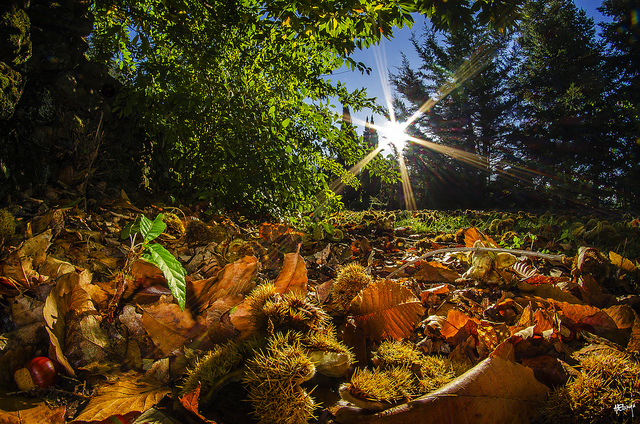
When I was growing up in suburban Maryland, every fall would bring a familiar sound. Thud, thud, thud!—chestnuts falling in their hardy armor. My mom and I would gather them up and roast them. I loved peeling away the smooth veneer and eating the sweet, still-warm fruit nestled inside, like nature’s Ferrero Rocher.
I was not, however, so fond of the way in which we procured our chestnuts.
My mom hunted for them on suburban lawns. This was during the nineties—before foraging was a way of life, before it entered the lexicon of popular (now mainstream) “foodie” movements, before bearded chefs in Brooklyn were cooking local and seasonal. My mom and I wandered into people’s yards, into patches of wooded private land, and picked up chestnuts by the plastic shopping bagful.
“Mom, this is probably illegal,” I would tell her, hoping my protests would get me out of the chore. What if someone I knew from school saw us? Would they think we were poor, that we couldn’t afford food from a store?
But my mom would press on gleefully, giddy at the thought of collecting her favorite seasonal treats.
Chestnuts are well protected by their shells. When she came across one of them, my mom would pry it open on the spot. She would place the ball and big toe of her left foot on one side of the split husk, then carefully do the same with her right foot—as though she were in a balancing act at the circus. The husk would give in to her weight and split open to yield its shiny brown nut. If she were in a hurry, the whole spiky thing would just be thrown into the bag—to be shucked later by my child labor.
I recently discovered that my stepmother is also an avid forager. She pulls her car over whenever she spots a good patch of wild dandelion greens or perilla leaves. She has brought home the thinnest twigs of a mulberry tree to dry roast in the oven for a nutty, golden-amber tea. Mulberry is good for diabetics, she has told me. Some years she picks up pounds and pounds of acorns that have fallen in yards or parks to make acorn starch. In Korean, she has described to me the painstaking, multiday process. She starts by soaking and rinsing the acorns multiple times to leach out their bitter and toxic tannins. Then she removes their little stemmed caps and thoroughly dries the nuts until no moisture remains. Finally, she grinds them up into a fine brown powder.
Why would my stepmother spend days to make acorn starch when she could so easily buy it at the local Korean market? Foraging, she tells me, lets her step out of her car and leave behind the grocery store and her factory job. She can breathe the crisp fall air and focus on the task at hand. She knows the exact source of her ingredients, having made good use of the bounty that the land right outside her doorstep has to offer. Seeing the process from beginning to end also gives her a sense of satisfaction, she says—much in the way that a chef takes pride in her quality control.
I suspect that foraging is also a way for both my mom and stepmother to make a foreign land a familiar one. It thrills them to recognize an ingredient—a wild plant, nut, or mushroom—and transform it into a dish that can transport them back to their childhood and their place of birth. With this ritual, they create a sense of home.
Sandra Hong Sandra Hong is a freelance writer based in Hong Kong. After a stint in finance, she delved into her love of eating and cooking by attending the International Culinary Center in New York and then working in a restaurant and a cafe in Hong Kong. She devotes her spare time to running, traveling, and volunteering for the Hong Kong chapter of Slow Food International.
- Follow us on Twitter: @inthefray
- Comment on stories or like us on Facebook
- Subscribe to our free email newsletter
- Send us your writing, photography, or artwork
- Republish our Creative Commons-licensed content

